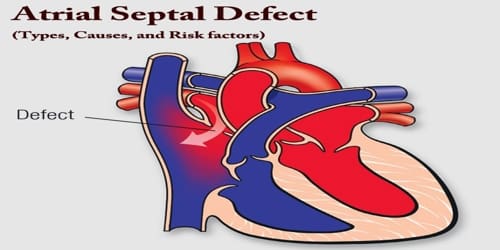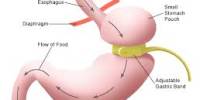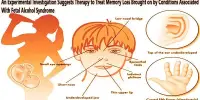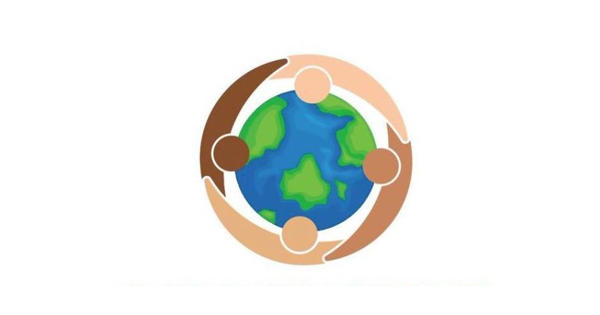Atrial Septal Defect (Types, Causes, and Risk factors)
Definition: Atrial septal defect (ASD) is a birth defect of the heart in which there is a hole in the wall (septum) that divides the upper chambers (atria) of the heart. Some flow is a normal condition both pre-birth and immediately post-birth via the foramen ovale, however, when this does not naturally close after birth it is referred to as a patent (open) foramen ovale (PFO).
This defect allows oxygen-rich blood to leak into the oxygen-poor blood chambers in the heart. ASD is a defect in the septum between the heart’s two upper chambers (atria). The septum is a wall that separates the heart’s left and right sides.
If one of these openings does not close, a hole is left, and it is called an atrial septal defect. The hole increases the amount of blood that flows through the lungs and over time, it may cause damage to the blood vessels in the lungs. Damage to the blood vessels in the lungs may cause problems in adulthood, such as high blood pressure in the lungs and heart failure. Other problems may include abnormal heartbeat and increased risk of stroke.
Small defects may never cause a problem and may be found incidentally. It’s also possible that small atrial septal defects may close on their own during infancy or early childhood.
An ASD may not produce noticeable signs or symptoms, especially if the defect is small. Also, in terms of health risks, people who have had a cryptogenic stroke are more likely to have a PFO than the general population.
An adult who has had an undetected atrial septal defect for decades may have a shortened lifespan from heart failure or high blood pressure that affects the arteries in the lungs (pulmonary hypertension). Surgery may be necessary to repair atrial septal defects to prevent complications.
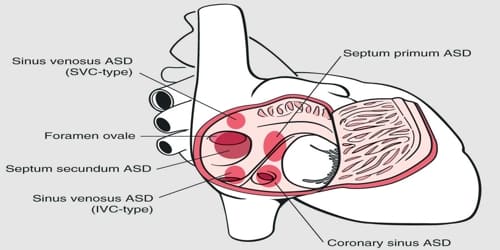
Types of Atrial septal defect: The many types of atrial septal defects are differentiated from each other by whether they involve other structures of the heart and how they are formed during the developmental process during early fetal development.
- Ostium secundum atrial septal defect – The ostium secundum atrial septal defect is the most common type of atrial septal defect and comprises 6–10% of all congenital heart diseases.
- Patent foramen ovale – A patent foramen ovale (PFO) is a remnant opening of the fetal foramen ovale, which normally closes after a person’s birth. In medical use, the term “patent” means open or unobstructed. In about 25% of people, the foramen ovale fails to close properly, leaving them with a PFO.
- Sinus venosus atrial septal defect – A sinus venosus ASD is a type of atrial septum defect in which the defect involves the venous inflow of either the superior vena cava or the inferior vena cava.
- Ostium primum atrial septal defect – Ostium primum defects are less common than ostium secundum defects. This type of defect is usually associated with Down syndrome.
- Common or single atrium – Common (or single) atrium is a failure of development of the embryologic components that contribute to the atrial septal complex. It is frequently associated with heterotaxy syndrome.
The interatrial septum can be divided into five septal zones. If the defect involves two or more of the septal zones, then the defect is termed a mixed atrial septal defect.

Causes and Risk factors of Atrial septal defect: The causes of heart defects such as atrial septal defect among most babies are unknown. Doctors know that heart defects present at birth (congenital) arise from errors early in the heart’s development, but there’s often no clear cause. Genetics and environmental factors may play a role.
Every child is born with an opening between the upper heart chambers. It’s a normal fetal opening that allows blood to detour away from the lungs before birth. After birth, the opening is no longer needed and usually closes or becomes very small within several weeks or months. The heart is divided into four hollow chambers, two on the right and two on the left. To pump blood throughout the body, the heart uses its left and right sides for different tasks.
Some of the other causes are:
- Down syndrome – patients with Down syndrome have higher rates of ASDs, especially a particular type that involves the ventricular wall. As many as one-half of Down syndrome patients have some type of septal defect.
- Ebstein’s anomaly – about 50% of individuals with Ebstein anomaly have an associated shunt between the right and left atria, either an atrial septal defect or a patent foramen ovale.
- Fetal alcohol syndrome – about one in four patients with fetal alcohol syndrome has either an ASD or a ventricular septal defect.
- Holt–Oram syndrome – both the osteium secundum and osteum premium types of ASD are associated with Holt–Oram syndrome
- Lutembacher’s syndrome – the presence of a congenital ASD along with acquired mitral stenosis
These types of heart defects also are thought to be caused by a combination of genes and other risk factors, such as things the mother comes in contact with in the environment or what the mother eats or drinks or the medicines the mother uses.
Risk of having a baby with a heart defect, including:
- Rubella infection
- Drug, tobacco or alcohol use, or exposure to certain substances
- Diabetes or lupus
- Obesity
- Phenylketonuria (PKU)
Due to the communication between the atria that occurs in ASDs, disease entities or complications from the condition are possible. Patients with an uncorrected atrial septal defect may be at increased risk for developing a cardiac arrhythmia, as well as more frequent respiratory infections.
However, having a larger defect or having complications such as heart failure, arrhythmias or pulmonary hypertension can increase people’s risk of complications during pregnancy. Doctors strongly advise women with Eisenmenger syndrome not to become pregnant because it can endanger their lives.
Information Source:
